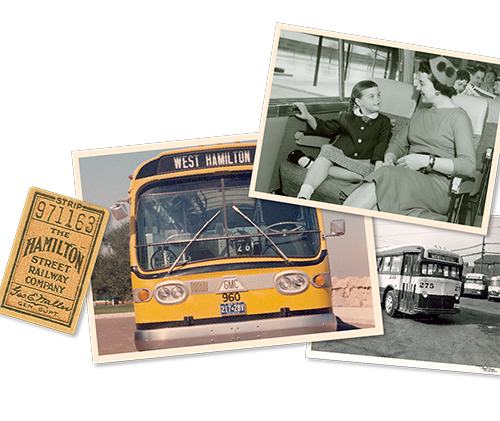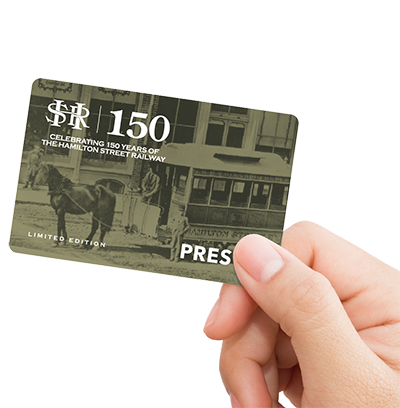HSR 150

As part of the 150th Anniversary celebrations, HSR is seeking stories and high-resolution photos from the community for promotional and marketing purposes.

You're Invited!
Join us for this special anniversary exhibit as we explore HSR’s legacy, see artifacts and photographs for the very first time and look forward to Hamilton’s bright transit future.
Moving Hamilton Forward for 150 Years
In 2024, we're celebrating 150 years of Hamilton Street Railway (HSR) operations. Since 1874, the HSR has been integral to Hamilton's history, connecting communities and facilitating opportunities for residents and visitors.
Some of the ways we're celebrating:

Limited Edition PRESTO Cards
Starting May 21, get your commemorative HSR 150 PRESTO card at HSR Customer Service, 36 Hunter St. E.
Cards can be purchased for $4, while supplies last. Featuring the iconic horse and buggy, this limited-edition card honours HSR’s history.
From Horses to Horsepower: A Brief History of the HSR
In May 1874, the city entered the "modern era" when the first Hamilton Street Railway horse-drawn streetcar took to city streets, making it one of the longest-running transit agencies in Canada. The streetcar ran on rails and was pulled by horses. HSR started service with six streetcars, 22 horses and three ¼ miles of track. The earliest vehicles seated 14 passengers.
Beginning in 1892, electricity was used to power the vehicles. This new technology made the service much faster. Cars now zoomed along at a furious 15 mph. Some streetcars had closed-in sides, but others were open-sided, making them popular for summertime outings.
Up until 1899, the HSR was owned by individual shareholders. With the coming of electrification, the interests of power companies expanded considerably. Hamilton Cataract Power, Dominion Power & Transmission, and later the Hydro-Electric Power Commission of Ontario were successive owners of the HSR until after World War II.
During these years, the city expanded, as did the need for public transit. From the days of the Great Depression in the 1930s through the mid-1940s and World War II, equipment was pushed to the maximum.
A group, which included Francis Farwell, owner of Canada Coach Lines, assumed ownership of the HSR in 1946. Within a few months, it was announced that streetcars would be phased out in five years.
On April 6, 1951, thousands of onlookers jammed Gore Park to witness ceremonies when the old streetcar made its symbolic final run.
Bring on the buses
Buses had actually been around for quite a while. By the mid-1920s, it had become apparent that motor buses would be more efficient than streetcars on some routes. By August 1926, buses ran on the Balmoral/Main route, with Cannon following the following year.
In 1960, the City of Hamilton purchased the HSR and Canada Coach Lines from Farwell, and the Hamilton Transit Commission was established to operate the organization. Seventeen years later, the company came under the jurisdiction of the Regional Municipality of Hamilton-Wentworth, now the City of Hamilton.
Technical and service improvements over the years include:
- New higher frequency routes, such as the A and B lines of the BLAST network
- Bike racks on buses first introduced in 2007
- Route 18 Waterdown Mountaineer and MyRide on-demand service in Waterdown
- Mountain Climber Program, providing free rides up and down the escarpment for cyclists on HSR buses year-round
- A new combination bus stop pole and bench for customer seating was introduced in 2022
- We've been getting social since 2016 on Facebook, Instagram, and X (formerly Twitter)
- The HSR (re)Designed – a complete reenvisioning of the bus network was presented in 2023 and is in final design stages now. Council can expect the new Transit Growth Strategy to be presented in 2024.
Did you know?
- HSR was the first transit system in North America to use compressed natural gas as a fuel source. Starting with the first conversion of diesel buses to compressed natural gas in 1985, HSR's fleet of buses powered by compressed natural gas continues to grow. Nearly 90 percent of our buses will be powered by compressed natural gas by the end of 2024.
- Route 10 B Line was HSR's first express bus route. The B Line started buzzing in September 1986. This east-west express route stopped only eight times between McMaster University and Eastgate Square, cutting travel time across the city in half.
- The first issue of Bus News was published in 1986 – Bus News is still published four times a year! Stay in the know with Bus News
- We've been helping you cheer on the home team since 2005! The Ticats game day service has been getting you to and from the game, FREE! Learn more about the ticket-to-ride program.
HSR 150 is generously supported by platinum sponsor Vontas

Contact [email protected] for sponsorship opportunities.
